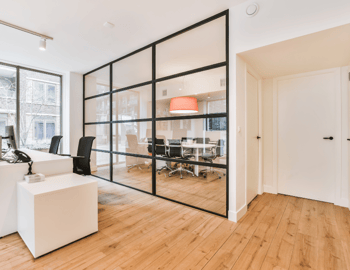
From Mod to Member: Pick Your Peer Group: Homogeneous vs. Heterogeneous Captives for WC
Part 4: Pick Your Peer Group: Homogeneous vs. Heterogeneous Captives for WC
Who You Stand Next To Matters
You've determined you're a fit for a captive (Part 1), you understand how the mechanics work (Part 2), and you've seen the advantages (Part 3). Now comes a critical strategic decision: Which type of group captive is right for your business?
The answer isn't just about structure or economics. It's about who you're pooling risk with, who you're benchmarking against, and whose board meetings you'll be sitting in. The peer group you choose shapes everything from underwriting terms to safety culture to long-term dividend potential.
Let's break down the two primary options and help you decide which fits your workers' comp risk profile.
 The Two Models: Same Industry vs. Mixed Industries
The Two Models: Same Industry vs. Mixed Industries
As we covered briefly in Part 2, group captives fall into two categories based on membership composition:
Homogeneous captives bring together businesses from the same industry. All members might be construction companies, manufacturers, healthcare providers, or distributors. Everyone shares similar operational exposures and faces comparable workers' comp risks.
Heterogeneous captives mix businesses from different industries. A member roster might include manufacturing, professional services, hospitality, distribution, and healthcare companies. Risk profiles vary widely across the membership.
Both structures work for workers' comp. The question is which one works better for your specific situation.
Homogeneous Captives: When Industry Alignment Matters
If your industry has unique workers' comp exposures, regulatory requirements, or safety challenges that don't translate well to other sectors, a homogeneous captive may be your best fit.
Advantages for Workers' Comp
Specialized coverage terms. When everyone in the captive faces similar risks, coverage can be tailored precisely. A construction captive understands scaffolding injuries, fall protection requirements, and subcontractor exposures. A healthcare captive understands needlesticks, patient handling injuries, and exposure to infectious diseases. The policy language, deductible structures, and coverage limits can be built around industry-specific realities.
Industry-specific underwriting. Actuaries and underwriters develop deep expertise in your sector. They understand seasonal patterns (construction work slows in winter, certain manufacturers have summer shutdowns), typical claim frequencies for your class codes, and how regulatory changes impact your industry. This expertise leads to more accurate pricing and reserve setting.
Peer benchmarking. When all members operate in the same space, performance comparisons are meaningful. If your experience mod is 0.85 and the captive average is 0.75, you know exactly where you stand relative to true peers. You can identify why other members are outperforming you and adopt their best practices.
Shared safety culture. Members face the same hazards and can share specific solutions. A manufacturer who has solved repetitive motion injuries on an assembly line can share those interventions with other captive members who have similar operations. Safety meetings become highly tactical rather than generic.
Regulatory alignment. Industries often face sector-specific OSHA standards, state regulations, or compliance requirements. A homogeneous captive can build these into governance structures, loss control programs, and claims handling protocols.
When Homogeneous Works Best for WC
Certain industries benefit disproportionately from homogeneous captives:
Construction. Highly variable exposure based on project type, geography, and subcontractor relationships. Benefits from specialized knowledge of construction-specific risks and OSHA requirements.
Healthcare. Unique exposures like patient handling, needlesticks, workplace violence, and exposure to pathogens. Benefits from medical provider networks that understand healthcare worker injuries.
Manufacturing. Risk profiles vary significantly by what's being manufactured and production methods used. Benefits from benchmarking against similar operations and sharing ergonomic solutions.
Transportation/Logistics. Vehicle accidents, loading/unloading injuries, and warehouse operations create specific risk patterns. Benefits from fleet safety programs and return-to-work strategies tailored to driver and warehouse roles.
Potential Drawbacks
Concentration risk. If your entire industry experiences a hard market, regulatory crackdown, or economic downturn, every member feels it simultaneously. There's no diversification to smooth volatility.
Limited perspective. When everyone faces the same challenges, breakthrough thinking can be harder to generate. Cross-industry insights that might solve problems differently aren't available.
Smaller membership pools. Industry-specific captives may have fewer potential members, which can limit economies of scale and risk spreading.
Heterogeneous Captives: When Diversification Matters
If your workers' comp risks are relatively standard, your safety program is strong across the board, and you value stability over industry-specific customization, a heterogeneous captive may be the better choice.
Advantages for Workers' Comp
Risk diversification. Different industries experience claim cycles at different times. Manufacturing might have a tough year while professional services runs clean. Construction might see increased claims during boom times (more hires, faster pace) while healthcare remains steady. This diversification smooths captive performance year over year.
Market cycle management. When one industry faces a hard insurance market (rates spiking, coverage restricted), other industries may be in soft markets. Heterogeneous captives aren't as exposed to industry-specific market dynamics.
Cross-industry best practices. Members bring diverse approaches to safety, claims management, and return-to-work programs. A hospitality company might have innovative light-duty programs that a manufacturer never considered. A professional services firm might have wellness initiatives that reduce injury frequency across all sectors.
Broader membership base. Heterogeneous captives can draw from a larger pool of potential members, which creates economies of scale in administration, purchasing power with TPAs and reinsurers, and deeper reserves for stability.
Governance diversity. Board members bring different business perspectives, which can lead to more innovative solutions and balanced decision-making.
When Heterogeneous Works Best for WC
Heterogeneous captives excel when:
Your WC exposures are relatively standard. Slip-and-falls, strains/sprains, vehicle accidents, and other common injury types don't require industry-specific expertise to manage effectively.
You prioritize stability over customization. You want predictable premium costs year over year and are willing to accept somewhat more generic coverage terms in exchange for that stability.
Your safety program is mature. You're already a top performer in your industry and have more to learn from diverse perspectives than from peer competitors.
You value governance efficiency. Heterogeneous captives often have more streamlined board processes because they're not debating industry-specific minutiae.
Potential Drawbacks
Less specialized coverage. Terms and conditions must accommodate a wide range of exposures, which can make highly customized coverage harder to negotiate.
Harder to benchmark. Comparing your claim frequency to an average that includes completely different industries provides limited insight.
Less peer learning. When a captive meeting includes construction, healthcare, hospitality, and manufacturing companies, the safety discussions must be generic rather than tactically specific.
How Peer Mix Impacts Key Workers' Comp Metrics
Your captive's peer composition directly affects how you track and improve performance.
Experience Mod Improvement Plans
In a homogeneous captive, you can benchmark your mod against industry peers with similar class codes. If the captive average is 0.78 and yours is 0.92, you have clear targets. The captive might even provide industry-specific experience mod improvement plans that address common injury patterns in your sector.
In a heterogeneous captive, mod comparisons are less apples-to-apples. A professional services firm with a 0.65 mod isn't a meaningful benchmark for a construction company. You're tracking your mod improvement over time, but peer comparison is limited.
Return-to-Work Metrics
Homogeneous captives can establish industry-specific return-to-work benchmarks. What's the average time from injury to modified duty placement for construction laborers? For healthcare nurses? For manufacturing line workers? When everyone's tracking similar roles, the data is actionable.
Heterogeneous captives track return-to-work at a higher level. They measure average days from injury to return across all members, but those averages blend very different job types and injury profiles.
Loss Frequency vs. Severity Tracking
Homogeneous captives can drill into frequency and severity patterns specific to your industry. If construction captive members are seeing increased frequency of fall-related injuries, that's immediately relevant to everyone. Safety interventions can be targeted industry-wide.
Heterogeneous captives track aggregate frequency and severity, but the drivers vary widely. One member's severity spike might be vehicle accidents while another's is slip-and-falls. The captive still tracks these metrics, but industry-specific trends are harder to identify.
Workers' Comp Captive KPIs
Both types track core KPIs:
- Claim frequency per 100 employees
- Average cost per claim
- Lost time vs. medical-only ratio
- Claim closure rates
- Return-to-work success rates
- Reserve accuracy
- Underwriting profit margins
The difference is in how actionable the benchmarking becomes. Homogeneous captives provide tighter, more relevant comparisons. Heterogeneous captives provide broader, more diverse data sets.
|
Metric |
Homogeneous |
Heterogeneous |
|
Experience Mod |
Industry peers |
Self over time |
|
Return-to-Work |
Role-specific days |
Aggregate average |
|
Loss Frequency |
Industry patterns |
Broad trends |
|
Benchmarking |
Tight comparisons |
Diverse data |
Use Cases: Real-World Scenarios
Let's look at how different businesses might evaluate this decision.
Case Study 1: Regional Construction Company
Profile: $3.5M in WC premium, 200 employees, primarily commercial construction in the Midwest, experience mod of 0.88
Decision factors:
- High industry-specific risks (falls, scaffolding, heavy equipment)
- Strong regional presence allows for in-person meetings with other construction firms
- Wants to benchmark against similar construction operations
- Regulatory environment (OSHA construction standards) affects entire industry
Best fit: Homogeneous construction captive. The specialized exposures, regional concentration, and need for construction-specific underwriting outweigh diversification benefits.
Case Study 2: Multi-Location Manufacturer
Profile: $850K in WC premium, 450 employees across five states, light assembly manufacturing, experience mod of 0.72
Decision factors:
- WC exposures are relatively standard (repetitive motion, occasional equipment injuries)
- Operations spread across multiple time zones
- Already performing well (low mod) and wants to learn from diverse perspectives
- Values premium stability as company grows
Best fit: Heterogeneous captive. Standard exposures, geographic spread, and strong existing performance make diversification more valuable than industry-specific customization.
Case Study 3: Healthcare System
Profile: $2.1M in WC premium, 800 employees, three hospitals and multiple clinics, experience mod of 0.95
Decision factors:
- Unique exposures (patient handling, needlesticks, workplace violence)
- Needs specialized understanding of healthcare worker injuries
- Wants to benchmark against other healthcare providers
- Interested in collaborative approaches to patient handling safety
Best fit: Homogeneous healthcare captive. The specialized nature of healthcare WC exposures and desire for peer benchmarking drive toward industry-specific structure.
Case Study 4: Professional Services Firm
Profile: $180K in WC premium, 120 employees, primarily office-based with some field consultants, experience mod of 0.65
Decision factors:
- Very low WC exposure overall (few claims, low severity)
- Exposures are standard (slips, vehicle accidents during business travel)
- Small premium makes economies of scale important
- Leadership team has limited time for governance
Best fit: Heterogeneous captive. Low exposure, standard risks, and need for efficiency make a broader, more streamlined captive structure ideal.
Making Your Decision: Questions to Ask Prospective Captives
Once you've identified whether homogeneous or heterogeneous better fits your profile, here are specific questions to ask when evaluating actual captive programs:
For Homogeneous Captives:
- What percentage of members are in my specific industry segment (not just broad category)?
- How does the captive handle industry-wide hard markets or regulatory changes?
- What industry-specific safety resources or loss control services are provided?
- Can you share benchmark data for my class codes from current members?
- How is governance structured to ensure all industry subsegments have representation?
For Heterogeneous Captives:
- What industries are currently represented and what's the mix?
- How does the captive ensure fair pricing when risk profiles vary widely?
- What's the track record of stability during industry-specific downturns?
- How are board seats allocated across different industries?
- Can members with unusual exposures still get appropriate coverage?
For Both Types:
- What's the average experience mod of current members?
- What are claim closure rates and return-to-work success rates?
- How transparent is the captive about individual member performance vs. aggregate?
- What's the governance time commitment (meetings per year, committee work)?
- What's the track record of dividend distributions to members?
The Bottom Line: Match Structure to Your Risk Profile
Neither homogeneous nor heterogeneous is inherently better for workers' comp. The right choice depends on:
Choose homogeneous if:
- Your industry has unique WC exposures requiring specialized expertise
- You value tactical peer benchmarking and industry-specific best practices
- Your geography allows for engaged governance participation with industry peers
- You're willing to accept less diversification in exchange for customization
Choose heterogeneous if:
- Your WC exposures are relatively standard and manageable
- You prioritize premium stability and diversification over industry-specific terms
- You value governance efficiency and diverse perspectives
- Your operations are geographically dispersed or class codes are varied
Most importantly, recognize that this decision isn't permanent. As your business evolves, your needs may change. A company that starts in a heterogeneous captive as a $200K premium mid-sized business might eventually move to a homogeneous structure as it grows to $2M in premium with more complex, industry-specific needs.
 Ready to Find Your Right Peer Group?
Ready to Find Your Right Peer Group?
Understanding which captive structure fits your risk profile is critical, but the real insight comes from modeling your specific numbers.
Schedule a 15-minute review with one of our captive specialists. Bring your experience mod, loss runs, and current premium breakdown. We'll walk through the scorecard together and show you what homogeneous vs. heterogeneous membership would look like for your business. Schedule your mod review call
Haven't taken the initial assessment yet? Start there: Take the online assessment to see if a captive is right for your business.
Want the complete picture of how captives work? Download the complete guide: Putting a Property and Casualty Group Captive to Work for Your Business.

